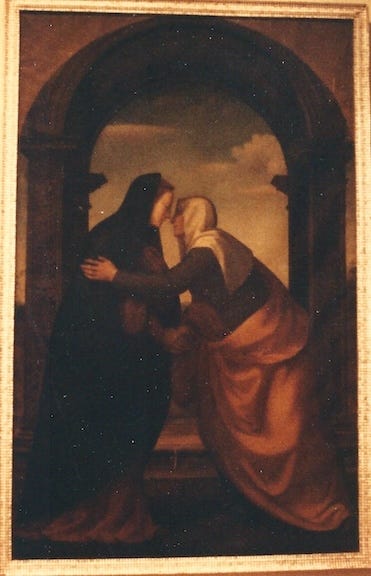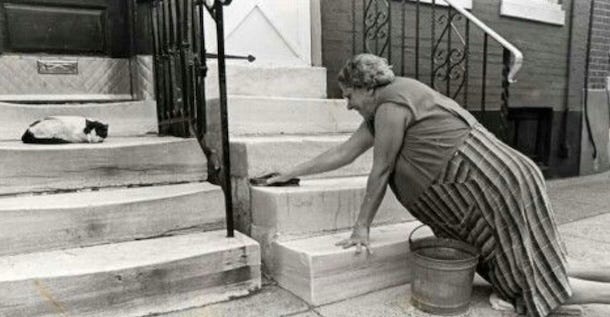Scrubbing white marble steps
Lifts her poor, half-hearted, weary and wandering children heavenward
"My childhood goes back to the days when many of us lived in row homes with marble steps. If you recall, there were at least four marble steps that adjoined your neighbor’s marble steps with what appeared to be a sliding board in between. Perhaps you can still envision adults and sometime children, on their knees, scrub brushes in hand and a container of Ajax cleanser nearby as they scrubbed the white marble steps. “ (Alonzo Kittrels, Philadelphia Tribune, January 16, 2021)
I’d walk the neighborhood around St. Elisabeth’s, South Philadelphia. One of the familiar sights on a Saturday morning in 1976 was women, Black and Italian, washing their marble steps. To live in these small row homes of the inner city was to be engaged in a fight with dirt and disorder. It was a positive pride, an expression of human dignity. You didn’t have much but you did have these lovely marble steps and you could make their beauty shine. You felt you could hold your head high and look your neighbor in the eye. And in doing that you affirmed the bonds of community.
Several years ago I commissioned an icon - The Slum Priests - it hangs in the nave at St. Clement’s, Seattle. There are five priests in the icon: Alexander Heriot Mackonochie, Charles Lowder, SSC, Robert Dolling, Arthur Stanton, and Lincoln Stanhope Wainright. They knew about lifting the eyes and hearts of their parishioners heavenward. Fr. Lowder’s view of worship: “He considered that it was as much his duty as parish priest to put before the eyes of his people the pattern of the worship in Heaven, as it was to preach the Gospel.” (p.133) When a visitor objected to the smell of incense, Fr. Stanton said, "Well there are only two stinks in the next world: incense and brimstone; and you’ve got to choose between them." … “Decorous restraint and academic discourse were like out of place in the slums. Mystery and movement, Color and ceremonial were more powerful. The Sacramental sign could speak more strongly than the written word. (From The Vision Glorious: Themes and Personalities of the Catholic Revival in Anglicanism, Geoffrey Rowell)
"The Mass is heavenward bound. So Mother Church catches her children up into color, ceremonial and music . . . She even helps her children to worship in the highest of spirits amid a blaze of lights and the glory of music and the majesty of the Liturgy which lifts her poor, half-hearted, weary and wandering children heavenward . . . We are not at Mass to express ourselves because it requires the poet, the musician, the artist, yes, the saint to do this for us. Wisely the Church uses in the Mass the best that can be produced by all of these combined. It is for us to say a grateful Amen." (Father Grieg Taber “Pray the Mass,” Saint Mary’s Press,1953; and from today’s Angelus.)
Of course, the need isn’t just that of the poor and working class. All humanity needs to lift its eyes. “I lift up my eyes to the hills; * from where is my help to come?” (Ps 121) Life is sacramental. So the ways of heaven touches us in cleaning the marble steps, and when the thurifer censes us; when walking on the street a stranger says “good morning” and when the Host is elevated.
Finally, beloved, whatever is true, whatever is honourable, whatever is just, whatever is pure, whatever is pleasing, whatever is commendable, if there is any excellence and if there is anything worthy of praise, think about these things (Philippians 4:8)
We see the same theme from John Orens, “In the secret places of their hearts, modern men and women are seeking themselves. They sense, although they cannot believe it, that they have enduring value, that there is more to themselves than their employers, their accountants, their government, or even their families can possibly know. What the world craves is the assurance that there is "a splendor burning in the heart of things." Naked dogma cannot supply this need, nor can empty ritual. Only the Catholic vision will suffice. But if the world is to find that vision it must be found in us, clothed in living thought and embodied in holy lives. ... Ours is the vocation of enchantment, restoring to humanity the divine image which sin has hidden but cannot destroy. It is a ministry of holy responsibility as well as delight. We must teach the truth to an age that does not believe in truth, preach hope to men and women bereft of confidence in the past or the future, and labor for justice in a time of ideological bankruptcy and political cynicism. But what will ultimately win souls--drawing human beings out of despondency to embrace their true selves, their brothers and sisters, and their God--is wonder: the spontaneous love and joy which lures us to Mass Sunday after Sunday.” (The Anglo Catholic Vision)
This abides.
Robert
The Feast of the Visitation of The Blessed Virgin Mary
Related
Scrubbing Baltimore’s Marble Steps Was My Very First Job






